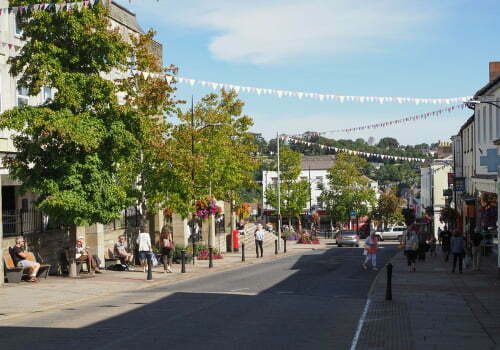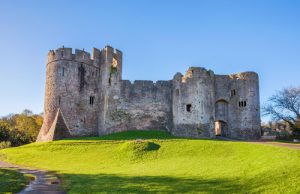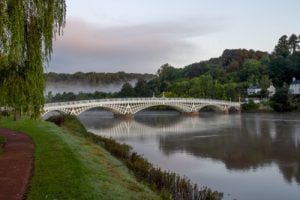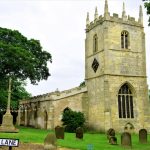
Chepstow in Brief
Chepstow is a town and community in the county of Monmouthshire, South Wales. It is situated on the English border, adjoining the county of Gloucestershire. It also lies on the River Wye, about 2 miles from its confluence with the River Severn. Chepstow also lies 16 miles (26 km) east of Newport, 28 miles (45 km) northeast of Cardiff, and 18 miles (29 km) northwest of Bristol. The town is particularly renowned for its ancient castle, said to be the oldest stone fortification in Britain. However, Chepstow is arguably best-known for its racecourse, which has hosted the Welsh Grand National for more than the last 70 years. In 2020, the town population was estimated at 12,376.
A Fleeting History
Early Settlement
Recent archaeological investigations have established the Thornwell area of Chepstow was continuously occupied from as early as 5000 BC until around AD 400. Iron Age camps have also been found within a couple of miles of the town centre at Bulwark, Piercefield, and Lancaut. Historians also think there was once a small Roman fort in the area, though the evidence is fairly scant. However, what is known is that Chepstow was located at a Roman crossing point of the River Wye between the towns of Glevum (Gloucester) and Venta Silurum (Caerwent). In the early 5th century, the Romans departed Britain, which saw Chepstow become part of the Kingdom of Gwent.
In the early Middle Ages, a small church dedicated to St. Cynfarch was built in Chepstow. Later, an Augustinian priory was built at the same site, though today there is no evidence of its existence. In the late 8th century, Offa’s Dyke, a large earthwork embankment demarking the Welsh Kingdoms from Mercia was constructed. The Dyke ran from its southerly point at Sedbury (about a mile from Chepstow), northwards for 177 miles to the Irish Sea.
The Normans
When the Normans conquered England in 1066, Chepstow was quickly recognised as a strategic location. Being the lowest bridging point of the River Wye, it made the ideal place to locate a military base for advancement into South Wales. In 1067, William FitzOsbern, the 1st Earl of Hereford, took the initiative and founded a stone castle at Chepstow. It was the first stone castle construction in the whole of Britain. A Benedictine priory was soon established nearby, the present-day site of St Mary’s Church. Monks from Cormeilles Abbey in Normandy soon took up residence at the priory. Though their numbers were few, the monks remained at the abbey up until Henry VIII’s mid-16th century Dissolution of the Monasteries.

Chepstow Castle. Image credit – Billy Stock/Shutterstock.com
The castle was expanded in the late 12th century, and again some 100 years later, by Roger Bigod, the 5th Earl of Norfolk. It was on Bigod’s initiative that a defensive wall was built (1272 -1282) around the entire town. Known as the ‘Port Wall’, it also helped to facilitate the collection of local taxes. The Wall’s only breach was ‘Town Gate’, which provided the only entrance to the town. Bigod also established the town’s first regular market and annual fair.
After the 14th century, the threat of Welsh insurgency lessened and the importance of the castle diminished. However, Chepstow then began to develop as an important market town and port. The town became chiefly known for the export of timber and bark from the Wye Valley. The wood was shipped as far afield as Iceland and Turkey. Wine was the town’s main import, which came from the South of France, Spain, and Portugal. At this time, it was local nobility known as ‘Marcher Lords’ who controlled the Welsh borders. Thus, taxation, if any, was favourably low, and outwith the English Crown.
The 16th to 18th Century
In 1524, Chepstow became part of the new county of Monmouthshire and received its first charter. During the mid-17th-century English Civil War, possession of the town and castle changed hands several times. The infamous ardent republican, Henry Marten, was imprisoned at the castle in 1668. He died there 12 years later and was buried at Chepstow’s St Mary’s Church.
As time passed, Chepstow’s port continued to grow in stature, such that by the end of the 18th century it was handling more tonnage than Cardiff, Newport and Swansea, combined. At this time, the town also began to develop as a tourist centre. The popular “Wye Tour” was mainly responsible for the rise in visitors to the area.
The 19th Century
The port’s importance peaked in the early 19th century during the Napoleonic Wars. This was mainly due to the increased demand for timber to make warships. In 1813, work began on a new bridge over the River Wye at Chepstow to replace the existing timber bridge. The state-of-the-art cast-iron 5 arch structure opened to great fanfare in July 1816. Originally known as Chepstow Bridge, it is now more commonly referred to as “Old Wye Bridge” or “Town Bridge”.

Chepstow’s cast-iron ‘Town Bridge’ opened in 1816. Image credit: Simon J Wilshire/Shutterstock.com
From the mid-19th century, a shipbuilding industry began to develop in Chepstow. This coincided with the arrival of the South Wales Railway (SWR) in the town. The line from Swansea, designed by the renowned Victorian engineer Isambard Kingdom Brunel, was completed in 1850. However, it became necessary to replace Brunel’s broad gauge track, with a standard gauge in 1872. Four years later, Chepstow became a busy station when the Wye Valley Railway from Monmouth opened. However, in 1886, the Severn Railway Tunnel opened, enabling Chepstow to be bypassed. The new stretch of the line provided a much more direct route between London and Cardiff. Thus, it followed that the number of trains passing through Chepstow was greatly reduced.
By the second half of the 19th century, Chepstow had become particularly renowned for the production of clocks, bells, and grindstones. At the same time, the port’s trade was beginning a steady decline. Bigger ships were needed to cope with the ever-increasing volume of local coal and steel exports. However, these larger vessels could not be easily handled by Chepstow. Thus, trade was increasingly switched to the nearby ports of Cardiff, Newport, and Swansea, located on the Bristol Channel.
The Modern Era
During WW1, National Shipyard No.1 was established at Chepstow to build much-needed merchant ships. From 1917 onwards, the great influx of shipyard labour led to large-scale housing developments at Hardwick (now Garden City) and Bulwark. Further housing developments directly north and south of the town centre soon followed.
In January 1959, the Wye Valley railway line closed to passengers, mainly due to the many years of sustained losses. A limited goods train operation continued on the line until January 1964. Afterward, freight traffic continued on the southern half of the route between Chepstow and Tintern Quarry. However, the line was finally abandoned in March 1990, when Tidenham Quarry closed.
The opening of the Severn Bridge in 1966 facilitated much easier commuting between Chepstow and the likes of Bristol and Cardiff. The enhanced connectivity encouraged house building across the whole of the town. More recently, house construction has been concentrated beyond the A466, west of the town.
Today, much of Chepstow’s old industries have disappeared, including its port function. The town’s main employment sector is retail and wholesale. Manufacturing is somewhat less than the average for the rest of Wales. Thus, the town is fairly reliant on tourism and has more than its fair share of independent shops and eateries.
Chepstow is twinned with Cormeilles, France.
Getting to Chepstow
By Road
Chepstow lies on the M48 about 6 miles northwest of the Severn Bridge. From the M4 East (Junction 21) or M4 West (Junction 23), take the M48 and exit at Junction 2 (Chepstow).
By Rail
Direct trains run to Chepstow from Birmingham, Cardiff, Cheltenham Spa, Derby, Gloucester, Newport, and Nottingham. From London (Paddington) change at Newport for Chepstow. A shuttle bus service operates from the train station to the town centre. Alternatively, you can walk it in 10 minutes.
By Air
Chepstow is approximately 30 miles from Bristol Airport and 45 miles from Cardiff Airport.
Notable People
- Richard Meade OBE (1938 – 2015) – is Britain’s most successful male equestrian Olympian. He was born in Chepstow on 4th December 1938. He was awarded an OBE in 1974 for his services to sport.
- James Stephens (1821 – 1889) – was a Chepstow-born stonemason and leader in the mid-19th century Chartist Movement. He was transported as a criminal to Australia, to later become a leading trade unionist.
- John Edward Parris (1911 – 1971) – was the first black footballer to represent Wales. He was born in Chepstow on 31st January 1911.
- Eleanor Anne Ormerod (1828 – 1901) was a pioneering entomologist, born near Chepstow. She was born on 11 May 1828 at Sudbury Park. Gloucestershire, just across the River Wye.
Did you know?
- The name Chepstow is derived from the Old English words ‘Chepe’ and ‘Stowe’, meaning marketplace
- The Welsh name for Chepstow is ‘Cas-Gwent’, meaning Castle of Gwent
- Between the 11th and 14th centuries, Chepstow was known as ”Striguil”. The name is thought to derive from Welsh, meaning ‘bend in the river’.
- Chepstow is located at the most easterly point in Wales
- ‘Tintern Abbey’, 5 miles north of Chepstow, was made famous by William Wordsworth in 1798. That was after his eponymous poem, inspired by his visit, was published.
Sport in Chepstow
Chepstow Town FC
Chepstow Town Football Club plays in the Ardal (District) League South East, the third tier of Welsh football. They play home games at Larkfield.
Chepstow RFC
Chepstow Rugby Football Club is a rugby union team that plays in the WRU Division 3 East. Nicknamed ‘The Stow’, they play home games at the Upper Memorial Ground.
Places to see in Chepstow
Chepstow Castle
One of the earliest stone castles in Britain (circa 1067) was built at Chepstow. The impressive Norman fortress is sited in a strategic location overlooking the River Wye. The castle is open daily from 9 am to 5 pm from April to October but has reduced opening hours from November until the end of March.
Chepstow Museum
The museum is housed in a fine Georgian townhouse, just opposite the castle entrance. The various exhibits and displays depict the town’s rich history, including the local maritime and shipbuilding story. There are also regular workshops, special exhibitions, and other activities. It’s open daily all year round from 11 am (2 pm Sun) and has free entry.
Bulwark Camp
Bulwark Camp, also known as Hardwick Camp, is a small defensive Iron Age hill fort, sited atop cliffs that overlook the River Wye and the Severn Estuary. It’s widely thought to have been built around the first century BC. It’s now a public open space.
St Mary’s Church
Chepstow’s Parish Church of St. Mary was founded around 1072 as a Benedictine Priory. Some parts of the church are original, most notably its western entrance. The church has been a Grade I listed building since 1950.
Town Gate and Port Wall
The original Town Gate dates to the late 13th century, built at the same as the Port Wall. It has had many uses over the years but now functions as a meeting room and houses the local Citizen’s Advice Bureau. Much of the Port Wall remains in excellent condition and can be viewed from a number of vantage points around the town.
Tintern Abbey
The ruined Abbey lies about 5 miles north of Chepstow set in spectacular countryside. Founded by Cistercian monks in 1131, it was almost entirely rebuilt, and enlarged, between 1220 and 1287.
Things to do in Chepstow
Take a Hike!
Chepstow is somewhat of a Mecca for walkers as it just happens to be at the origin of three national trails. The Gloucester Way, Offa’s Dyke Pathway, and the Wye Valley Walk, all start here. One of the most popular local walks is to hike along the Wye Valley Walk as far as Tintern Abbey. At the abbey, you can cross the river and walk back to Chepstow along Offa’s Dyke pathway. The very pleasant walk is about 12 miles (19 km) in total.
A Day at the Races

Image credit: Lesley Rigg/Shutterstock.com
Chepstow Racecourse plays annual host to Wales’ most prestigious race meeting; the Welsh Grand National. It’s also one of only 17 venues throughout the country that accommodates both flat and jump race meetings. In a normal year, Chepstow holds 31 race meetings, which are a mix of afternoon and evening events. The racecourse is also a popular venue for other happenings, such as a beer & cider festival, a classic car show, and live music events.
The National Dive Activity Centre
The NDAC is housed at a large flooded quarry at Tidenham, near Chepstow. The clear waters are some 700 m long and up to 80 m deep, making it an excellent scuba dive site. The Centre caters to both newcomers and seasoned divers. It’s also possible to gain PADI/SDI open water certificates at the Centre. There’s also bike hire, an aqua park, a zip slide, and a giant swing, at the site.
Where to Stay?
There are about 15 properties offering accommodation in or within a couple of miles of Chepstow. These tend to be either guesthouses, bed & breakfasts, or inns, in the £70 – £90 per night price range. Nearby villages like Tintern, Thornbury, and Wollaston, offer much the same choice of accommodation, at a similar price.
Thinking of moving to Chepstow?
Thinking of moving to Chepstow? The overall average property price in the Chepstow area for March 2022 stood at approximately £298,500. This represents a drop of about 6% on the average price paid in the previous year. In terms of property types, flats sold for an average of £178,000, terraced houses for £236,500, semi-detached for £258,500, and detached for £399,500.
Thinking of a Staycation?
Are you thinking of holidaying in the UK? If so, why not check out some of our other travel guides for some staycation ideas? I think you might be surprised at the variety of great things to do in the UK.
Header image credit: Claudio Divizia/Shutterstock.com
Why not take the Chepstow quiz?
Quiz Maker – powered by Riddle




